Top Free Headless CMS Platforms

It wasn't so long ago that websites were islands, barely capable of communicating with the mainland. They were isolated brochureware, a place where the sun rose and set on static information that was hard-coded like a pina colada on a tropical postcard.
In the early days (we're talking the ancient realm of the 1990s), CORBA offered the first common object requests between systems. It was later followed by SOAP – a protocol that acted more like a shortwave radio that communicated data but didn't provide any instructions for how a response should be handled.
It wasn't until REST that APIs were fully in motion. It provided an architectural style that delivered precise information to endpoints but also instructions on how to consume the data (think CRUD functions that create, read, update or delete).
While SOAP was still good for more stateful, conversational operations, REST rolled like a wave across the web and application layers of the Internet. Today, over 70% of public APIs are REST or "RESTish," meaning... well, almost everyone is using it. Now, as GraphQL matures and the API landscape expands, a decoupled approach to building digital experiences is more of the rule and not the exception.
This is exactly why the headless CMS has exploded in popularity. And there are a lot of platforms to choose from.
If you're searching for a headless CMS, don't lose your head (sorry, we had to do it). We're here to help.
In this article, we've assembled a list of solid solutions that offer a truly free experience. Fair warning: the word "free" means that a tier of a product is free forever. This often translates into a slimmed-down or limited entry with options to upgrade, but it's not a trial.
Before we dive in, a bit more about this hot category of content management systems.
What is a Headless CMS?
As the name implies, a headless CMS is a kind of backend content management system that separates or decouples the “body” – otherwise known as the content repository – from the presentation layer, often referred to as the "head." Content in a headless CMS is delivered through APIs, allowing it to be displayed across different devices and endpoints.
With traditional (or coupled) CMS platforms, the content management backend is completely tied to a website's front-end. This effectively limits content creators and developers just to the website pages and templates that are managed and rendered in the system itself.
With a headless CMS, you are truly "channel agnostic." That means you can manage content via the JAMstack (JavaScript, API, and Markup) with different front-end static site generators using React or Vue. But the omnichannel only begins at the website layer: with a headless CMS, you can manage content on a wide range of endpoints, from digital signs to wearable tech to IoT devices. The possibilities are endless.
Here are a few more key advantages of using a headless CMS:
- Freedom and control: With headless, there are no predefined templates or designs and no tight coupling between business apps and the CMS itself. This allows you to choose whatever technology or framework you want for your front-end app.
- Easy to use: Generally speaking, headless CMS platforms are much easier to deploy and less complicated to use. The more you integrate, the more complex things can get, but you start with something that's less cumbersome.
- Rapidly integrate new channels: Unencumbered by the limitations of a traditional CMS, you can add new devices and endpoints with ease.
- Single source: With a headless CMS, you have one platform to distribute all of your content from, giving you the ability to maintain standards and versions.
- API first: Purpose-built for APIs, a headless CMS is less resource-intensive and performs much faster.
- Secure and scalable: By decoupling the authoring and delivery layers, you can scale components separately while maintaining security.
Sounds awesome, right?
OK, so there are a few disadvantages to going headless. The big one: authors can't preview how their content appears in applications outside the CMS. This is something Preston So refers to as "digital orchestration" and the problem of headless CMS preview. It's a persistent issue across the headless horizon, particularly at the enterprise level – and it's forcing some platforms to rethink their models. There are also some limitations around analytics and personalization where a traditional CMS still has a leg up.
One more note: there are several "hybrid headless" platforms that provide both a coupled website CMS experience alongside a headless app (the best of both worlds, so to speak). These appeal to agencies or organizations with multiple apps that require different needs from their content teams within a single ecosystem. More on that in a future article.
Without further ado, here are the top free headless content management platforms you might want to evaluate:
Agility CMS
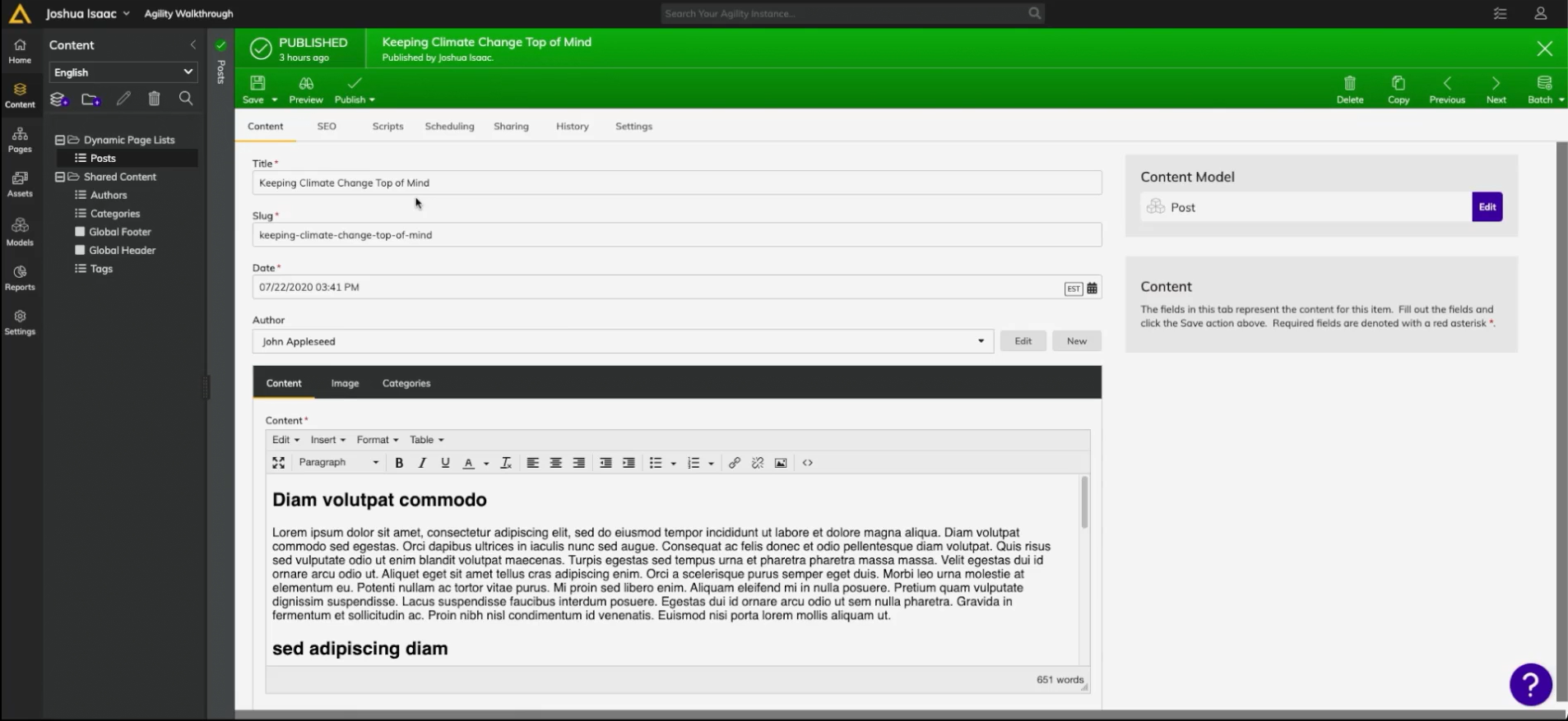
Agility is a cloud-native, API-First content management platform. Agility CMS's mantra is you shouldn't have to compromise, and they deliver on that with a wide range of best-in-class features.
With Agility, content editors have access to authoring tools they're already familiar with, such as content previewing and scheduling, page and sitemap management, SEO fields for optimization, and more. And by being an API-first platform, developers aren't limited to a specific language or framework – meaning they can deliver content to any front-end with any coding language.
Agility CMS works seamlessly with most of the popular JAMStack frameworks such as Next.js, Gatsby.js, and you can deploy to any hosting environment you want with dedicated integrations via Vercel and Netlify.
Agility's Developer plan is free forever, and it is great for developers working on personal sites. Agility CMS has also introduced a new pricing model for their all-in-one headless content management system, aimed at helping a broad range of customers – from developers to the enterprise – expand their digital strategies.
Learn more at agilitycms.com
Contentful
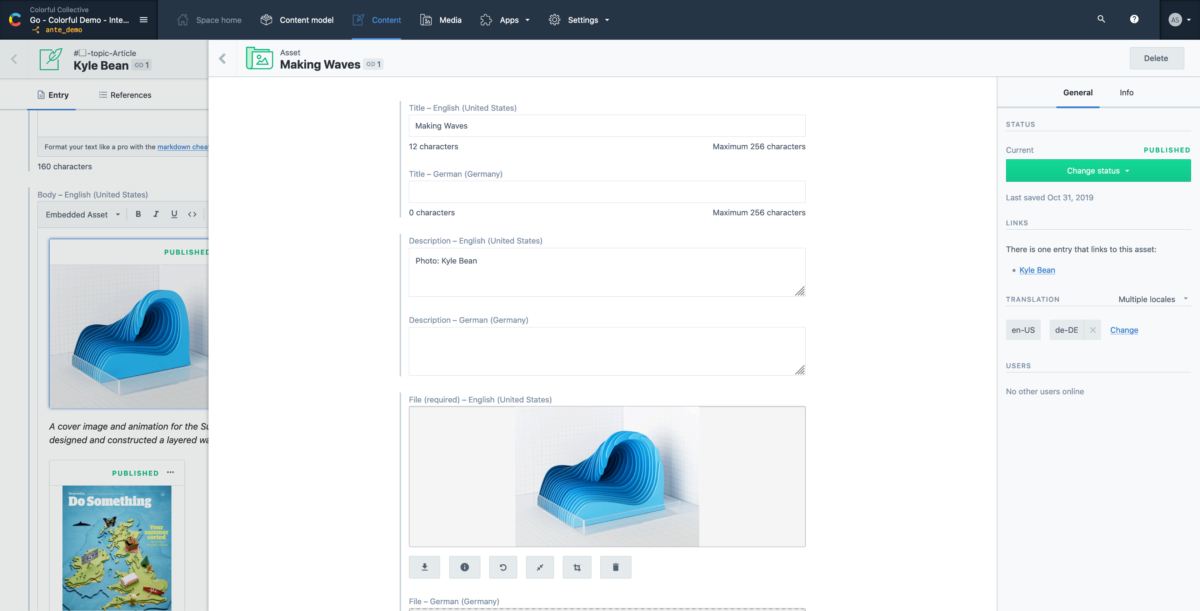
Contentful is a cloud-hosted headless content management system that works around a two-pillared philosophy: developer friendliness and isolated content management. As the name implies, Contentful prioritizes content and, despite being an API-first CMS that appeals to developers, is also just as approachable for content managers and strategists.
Contentful has an easy-to-use interface that is highly customizable. It also comes with a comprehensive toolbox of features such as localization, cloud governance that allows you to manage users with roles and permissions, and content modeling to create custom content types. Contentful also offers seamless integration with hundreds of other tools through open APIs with robust, highly configurable capabilities.
Contentful's Community plan is free forever for up to 5 users and includes their fully-featured headless CMS and GraphQL.
Learn more at contentful.com
Netlify CMS
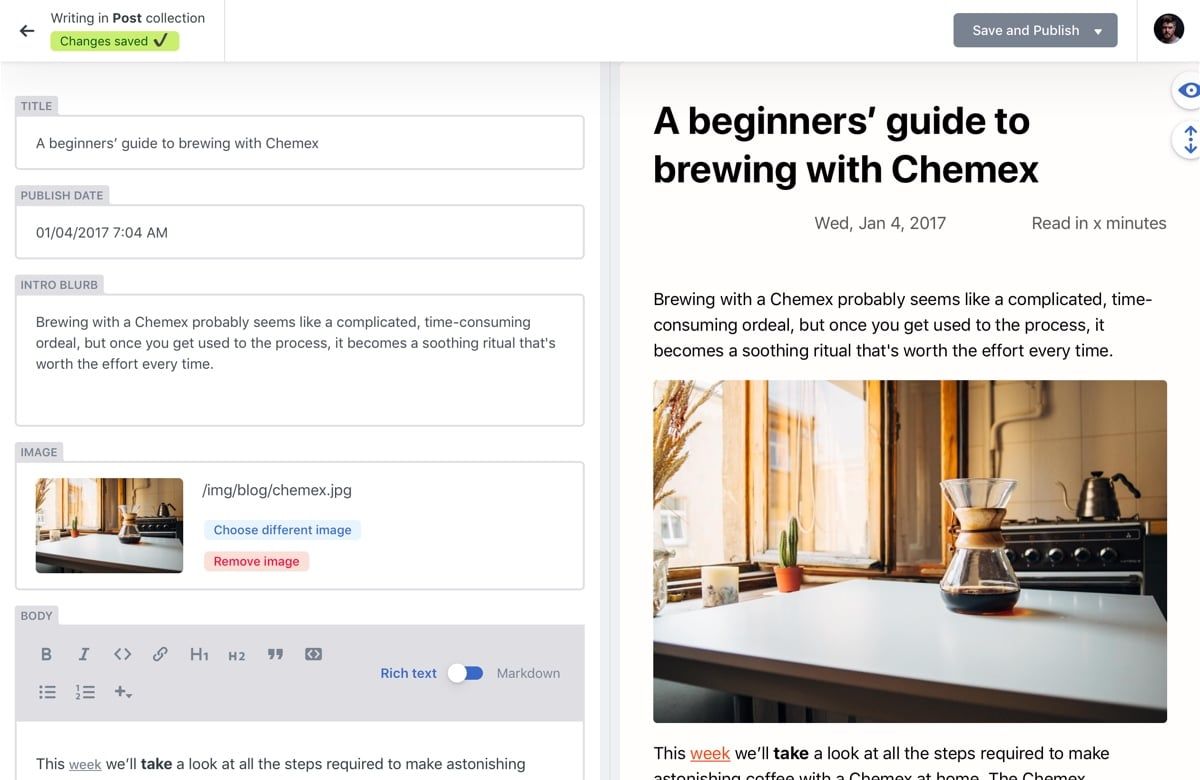
Netlify CMS is an open-source content management system that's purpose-built for your Git workflow. Designed as a single-page React app, Netlify can be paired with any static site generator to create faster, more flexible web projects.
With Netlify, your content is stored in your Git repo alongside your code for easier versioning, multi-channel publishing, and the option to handle content updates directly in Git. While Github might be your first choice, you're not restricted to the ecosystem – you can also use GitLab or Bitbucket API, all with modern authentication.
One of the big advantages of Netlify is that it has a fast, web-based UI that features rich-text editing, real-time preview, and drag-and-drop media uploads. You can specify an unlimited number of content types with custom fields and create custom-styled previews, UI widgets, and editor plugins – making it all flexible and extensible. They also offer pre-configured templates, making it easy to get started.
Netlify CMS is platform-agnostic, so it works with most static site generators. It's super easy to install: just add two files to your site and hook up the backend via your build process or by linking via their CDN.
Netlify is free forever and open source – and has a big community supporting it. The CMS also features a seamless connection to Netlify's core infrastructure for the JAMstack.
Learn more about Netlify CMS at netlifycms.org
Sanity
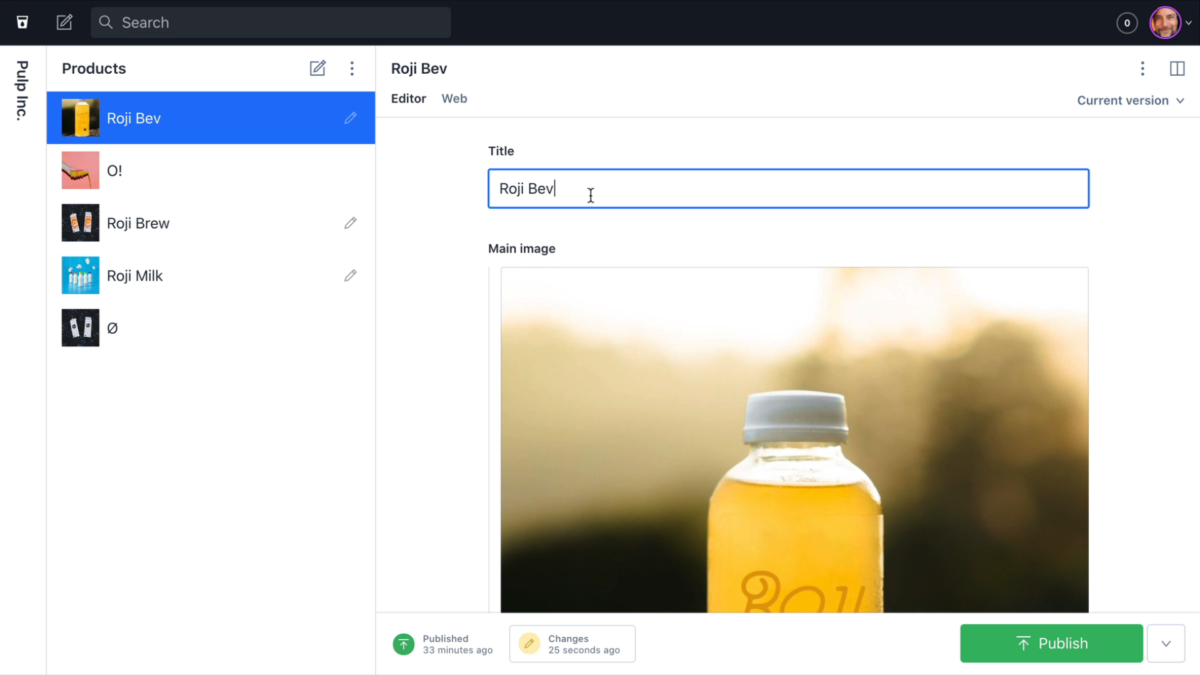
Sanity is a platform for structured content. In addition to being open-source, API-based, and headless, Sanity invented a whole new approach to building websites. Instead of thinking in terms of web pages, Sanity uses structured content for page building.
Sanity positions itself as a "fast-growing alternative to the traditional CMS." What makes Sanity unique is that it treats content as data. By storing resources in their Sanity Content Lake, organizations can effectively de-silo their content – making it available for both collaboration and global distribution. By leveraging APIs, users can manage their text, images, and other media in a unified platform and build engaging digital experiences in real-time.
Sanity recently raised $39 million to focus on growth – so you can be sure that the platform will provide even more innovative product experiences.
Sanity offers very transparent and flexible pricing, but it also sports a free plan with a generous usage quota including 3 users, 10GB Bandwidth per month, and 500k API CDN Requests per month. You can also upgrade to a Team, Business, or Enterprise package.
Learn more at sanity.io
Storyblok
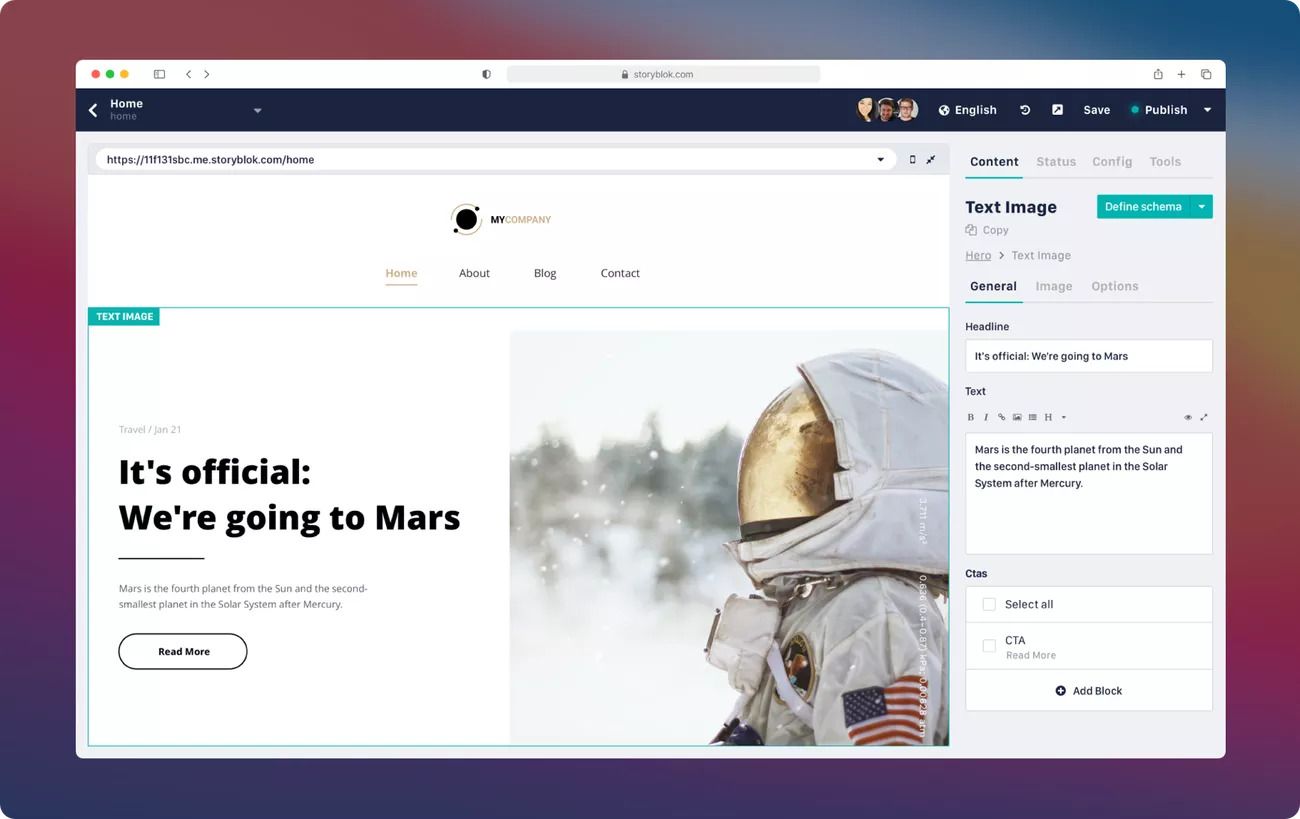
Storyblok has the distinction of being one of the only headless content management systems with a visual editor. It provides developers with all the flexibility they need to build fast, reliable websites while giving content creators with no coding skills the ability to edit independently.
The term "headless" can be very intimidating to non-developers. Storyblok attempts to ease that burden by offering a unique combination of visual editing tools and highly customizable content blocks – all designed with marketers in mind. Conversely, Storyblok provides a modern headless architecture that gives code fanatics the flexibility to build custom digital experiences with rich features.
The visual composer is the heart of Storyblok. It lets you manage your content simply by browsing your website. As you click on various elements, a sidebar appears on the right side with options to edit your content. You also create reusable components that make the content management experience far more efficient.
Storyblok is free for single developers, and it has a generous quota, including unlimited API requests, unlimited components, and content types, internalization, and unlimited assets.
Learn more at storyblok.com
Strapi

With more than 35,000 stars on GitHub, 600 contributors, and 3.5 million+ downloads, Strapi is the fastest-growing Node.js CMS. As a headless CMS, Strapi powers experiences across websites, mobile applications, and IoT devices – making it an ideal fit for the JAMstack.
Strapi is designed to work with popular front-end frameworks, including React, Gatsby, Vue.js, Next.js, and other static site generators. It also supports multiple databases as well as both REST and GraphQL APIs.
Strapi's features deliver a flexible publishing experience to content managers. The content types builder provides the freedom to create any page on the go. You can also make reusable collection types such as blog posts, products, repeatable components, dynamic zones, and more. Strapi just released v3.6, which now includes free content internationalization.
Strapi's Community Plan is free forever. The plan includes both REST and GraphQL APIs, unlimited usage (entries, API calls, assets, etc.), unlimited locales, and community support. Currently, all plans are self-hosted, but Strapi is working on launching the Strapi Cloud, which is fully hosted and managed.
Strapi is now listed in the DigitalOcean Marketplace, where it can be deployed in less than two minutes.
Learn more at strapi.io
Graph CMS (Now Hygraph)
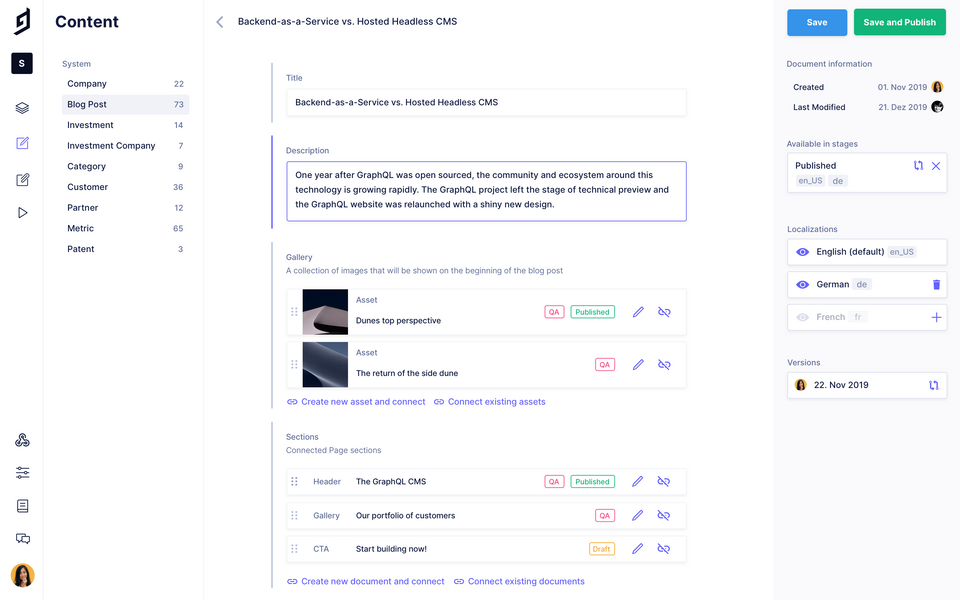
GraphCMS, as you can guess from the name, is the first headless content management system that fully utilizes the power of GraphQL.
GraphCMS has something for everyone on a team. It enables developers to build powerful content APIs in a matter of minutes while giving content editors all the tools they need to manage their content.
For developers, GraphCMS offers a very flexible development environment. Their API is easy to use and allows for quick development. Their API Playground is a great way to experiment with data as well as debugging. Graph's localization API also makes it easy to build multi-language sites.
For non-technical people, GraphCMS offers an intuitive UX. The GraphCMS Content Studio provides a rich editing experience with digital asset management, content staging, previews, and more – all with granular roles and permissions.
GraphCMS has a community plan which is completely free. The plan is fully hosted with built-in digital asset management and their assets transformation API. The community plan hosts up to 5 users and allows up to 1 million monthly API calls and 100GB in monthly asset traffic.
Learn more at hygraph.com/
Conclusion
When we said there are a lot of headless CMS platforms, we meant it. In fact, if you're poking around the JAMstack.org website, you'll find almost 100 different options. Trying to find the right one might be harder than drinking from a firehose. Hopefully, this list can help narrow down your efforts, but there are definitely some niche platforms that could fit the bill.
In this post, we researched and analyzed the top free options that really deliver on the word "free." That means forever with limited strings attached. That said, some of the most reputable headless CMS options like Ghost CMS are open source and offer a free 14-day trial with starter plans for as little as $9 a month.
Regardless of where you are on your journey, ask yourself these key questions when evaluating a headless CMS:
- Is headless right for your needs?
- Have you established your goals and prepared a comparison matrix?
- How easy is it to scale?
- What does the developer ecosystem look like?
- What sort of tools, SDKs, and off-the-shelf integrations does it come with?
- If you're a marketer, is it low-code friendly?
- From an API perspective, is it both REST and GraphQL ready?
More questions? Contact us, and we'll get you inside the heads of one of our CMS Experts.